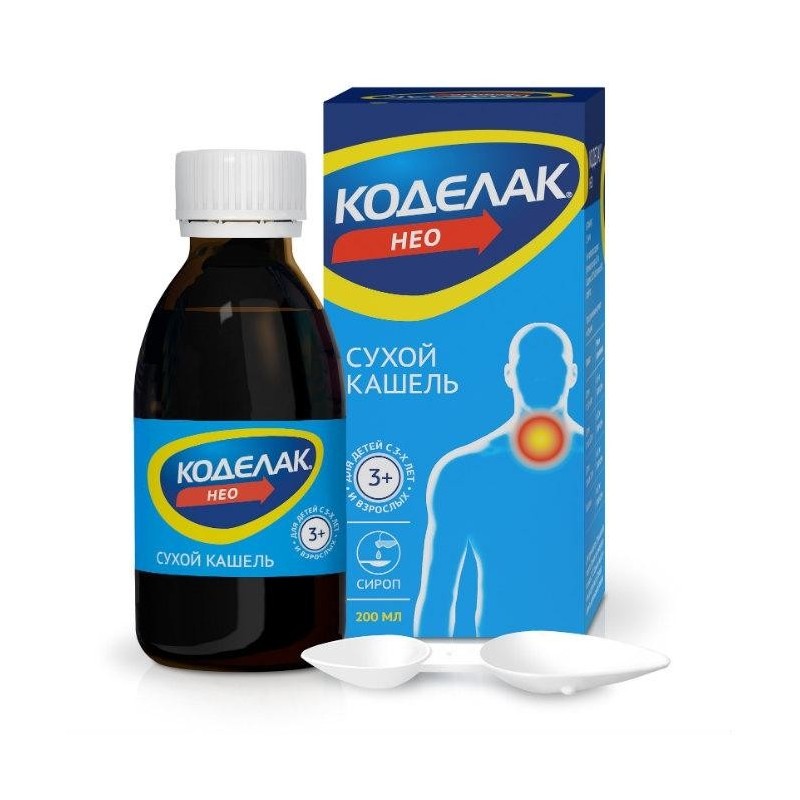



Codelac Neo is an antitussive, expectorant, bronchodilator, anti-inflammatory.
Pharmacodynamics
Antitussive non-opioid agent, has a direct effect on the cough center. Butamirate citrate is neither chemically nor pharmacologically related to opium alkaloids. It has an antitussive, expectorant, moderate bronchodilating and anti-inflammatory effect, improves spirometry indices (decreases the resistance of the respiratory tract) and oxygenation of the blood.
Pharmacokinetics
Drops for oral administration, syrup
Suction. After oral administration, the drug is rapidly and completely absorbed from the gastrointestinal tract. After taking 150 mg butamirata Cmax The main metabolite (2-phenylbutyric acid) in blood plasma is reached in about 1.5 hours and is 6.4 mcg / ml.
Distribution and metabolism. The hydrolysis of butamirate, initially to 2-phenylbutyric acid and diethylaminoethoxyethanol, begins in the blood. These metabolites also have antitussive activity, and, like butamirata, are largely (about 95%) bound to plasma proteins, which makes them lasting T1/2. 2-phenylbutyric acid is partially metabolized by hydroxylation.
When re-taking the drug cumulation is not observed.
Derivation. T1/2 makes 6 h. All three metabolites are removed mainly with urine. Moreover, 2-phenylbutyric acid is mainly derived in the form associated with glucuronic acid.
Dry cough of any etiology (for colds, flu, whooping cough and other conditions); suppression of cough in the preoperative and postoperative period, with surgical interventions and bronchoscopy.
5 ml of syrup contains:
Active substance: butamirata citrate (in terms of 100% substance) 7.5 mg;
Excipients: sorbitol (Neosorb 70/70, sorbitol syrup) - 2025 mg; glycerol (glycerin) - 1450 mg; ethanol 95% (ethyl alcohol 95%) - 12.69 mg; sodium saccharin - 3 mg; benzoic acid - 5.75 mg; vanillin - 3 mg; sodium hydroxide solution 30% - 1.55 mg; purified water - up to 5 ml
Butamirate is marketed under different brands and generic names, and comes in different dosage forms:
| Brand name | Manufacturer | Country | Dosage form |
|---|---|---|---|
| Codelac Neo | Pharmstandard | Russia | syrup |
| Codelac Neo | Pharmstandard Ufavita | Russia | pills |
| Omnitus | Hemofarm | Serbia | syrup |
| Omnitus | Hemofarm | Serbia | pills |
| Sindecod | Novartis | Switzerland | syrup |
| Sindecod | Novartis | Switzerland | drops |
No customer reviews for the moment.
Children from 3 to 6 years old - 5 ml 3 times a day; from 6 to 12 years old - 10 ml 3 times a day; 12 years and older - 15 ml 3 times a day; adults - 15 ml 4 times a day.
When taking the drug should use a dimensional device.
From the side of the central nervous system: dizziness, passing when taking the drug or reducing the dose; drowsiness.
From the digestive system: nausea, vomiting, diarrhea.
On the part of the skin: exanthema.
Allergic reactions: skin rash, itching.
No drug interactions for butamirate are described. During the period of drug treatment is not recommended to drink alcoholic beverages, as well as drugs that depress the central nervous system (including hypnotics, neuroleptics, tranquilizers).
There are no data on the safety of the drug during pregnancy and passing it through the placental barrier. The use of the drug in the first trimester of pregnancy is contraindicated. In the II and III trimesters of pregnancy, the use of the drug is possible, taking into account the ratio of benefits to the mother and the potential risk to the fetus.
The penetration of the drug into breast milk has not been studied, so the use of the drug during breastfeeding is not recommended.
There is a danger when using the drug in patients with a tendency to develop drug dependence, with liver diseases, alcoholism, epilepsy, and brain diseases.
Drops for oral administration, syrup. The drug can be used for patients with diabetes, because sucrose or glucose is not used as a sweetener.
pills with modified release film coated. Each tablet contains 241 mg of lactose. The drug is contraindicated in patients with lactose intolerance, lactase deficiency, glucose-galactose malabsorption.
Influence on ability to steer vehicles and work with mechanisms. It is recommended to refrain from driving and practicing other potentially hazardous activities that require increased concentration and psychomotor speed, because The drug may cause drowsiness and dizziness.
Symptoms: nausea, vomiting, drowsiness, diarrhea, abdominal pain, dizziness, irritability, decreased blood pressure, poor coordination of movements.
Treatment: the appointment of Activated charcoal, gastric lavage, saline laxatives, symptomatic therapy (if indicated).
Studies and clinical trials of Butamirate (Click to expand)